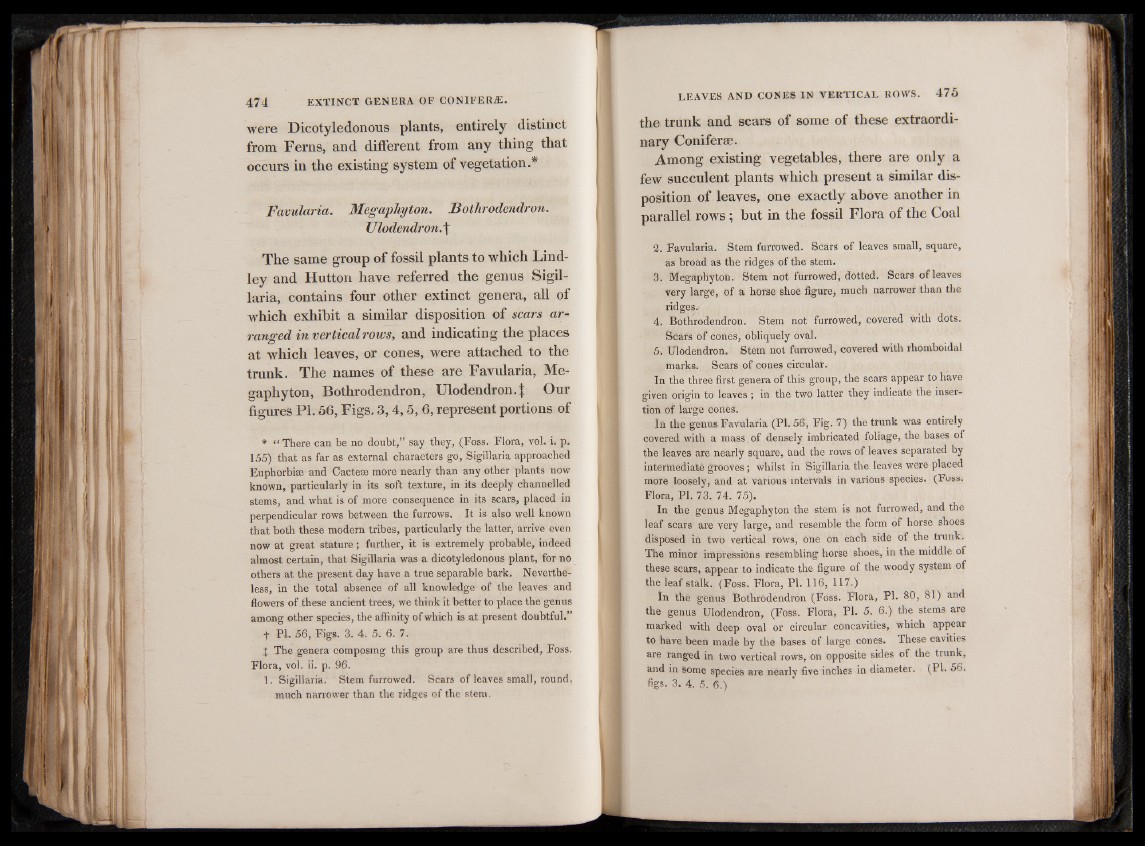
were Dicotyledonous plants, entirely distinct
from Ferns, and different from any thing that
occurs in the existing system of vegetation.*
Favularia. Megaphyton. JBothrodendron.
Ulodendron.^
The same group of fossil plants to which Lind-
ley and Hutton have referred the genus Sigil-
laria, contains four other extinct genera, all of
which exhibit a similar disposition of scars arranged
in vertical rows, and indicating the places
at which leaves, or cones, were attached to the
trunk. The names of these are Favularia, Megaphyton,
Bothrodendron, Ulodendron.J Our
figures PI. 56, Figs. 3,4,5, 6, represent portions of
* “ There can be no doubt,” say they, (Foss. Flora, vol. i. p.
155) that as far as external characters go, Sigillaria approached
Euphorbias and Cacteee more nearly than any other plants now
known, particularly in its soft texture, in its deeply channelled
stems, and what is of more consequence in its scars, placed in
perpendicular rows between the furrows. It is also well known
that both these modern tribes, particularly the latter, arrive even
now at great stature; further, it is extremely probable, indeed
almost certain, that Sigillaria was a dicotyledonous plant, for no
others at the present day have a true separable bark. Nevertheless,
in the total absence of all knowledge of the leaves and
flowers of these ancient trees, we think it better to place the genus
among other species, the affinity of which is at present doubtful.”
t PI- 56, Figs. 3. 4. 5. 6. 7.
I The genera composing this group are thus described, Foss.
Flora, vol. ii. p. 96.
1. Sigillaria. Stem furrowed. Scars of leaves small, round,
much narrower than the ridges of the stem.
LEAVES AND CONES IN VERTICAL ROWS. 475
the trunk and scars of some of these extraordinary
Conifer«.
Among existing vegetables, there are only a
few succulent plants which present a similar disposition
of leaves, one exactly above another in
parallel rows; but in the fossil Flora of the Coal
2. Favularia. Stem furrowed. Scars of leaves small, square,
as broad as the ridges of the stem.
3. Megaphyton. Stem not furrowed, dotted. Scars of leaves
very large, of a horse shoe figure, much narrower than the
ridges.
4. Bothrodendron. Stem not furrowed, covered with dots.
Scars of cones, obliquely oval.
5. Ulodendron. Stem not furrowed, covered with rhomboidal
marks. Scars of cones circular.
In the three first genera of this group, the scars appear to have
given origin to leaves ; in the two latter they indicate the insertion
of large cones.
In the genus Favularia (PI. 56, Fig. 7) the trunk was entirely
covered with a mass of densely imbricated foliage, the bases of
the leaves are nearly square, and the rows of leaves separated by
intermediate grooves; whilst in Sigillaria the leaves were placed
more loosely, and at various intervals in various species. (Foss.
Flora, PI. 73. 74. 75).
In the genus Megaphyton the stem is not furrowed, and the
leaf scars are very large, and resemble the form of horse shoes
disposed in two vertical rows, one On each side of the trunk.
The minor impressions resembling horse shoes, in the middle of
these scars, appear to indicate the figure of the woody system of
the leafstalk. (Foss. Flora, PI. 116, 117.)
In the genus Bothrodendron (Foss. Flora, PI. BO, 81) and
the genus Ulodendron, (Foss. Flora, PI. 5. 6.) the stems are
marked with deep oval or circular concavities, which appear
to have been made by the bases of large cones. These cavities
are ranged in two vertical rows, on opposite sides of the trunk,
and in some species are nearly five inches in diameter. (PI. 56.
figs. 3. 4. 5. 6.)